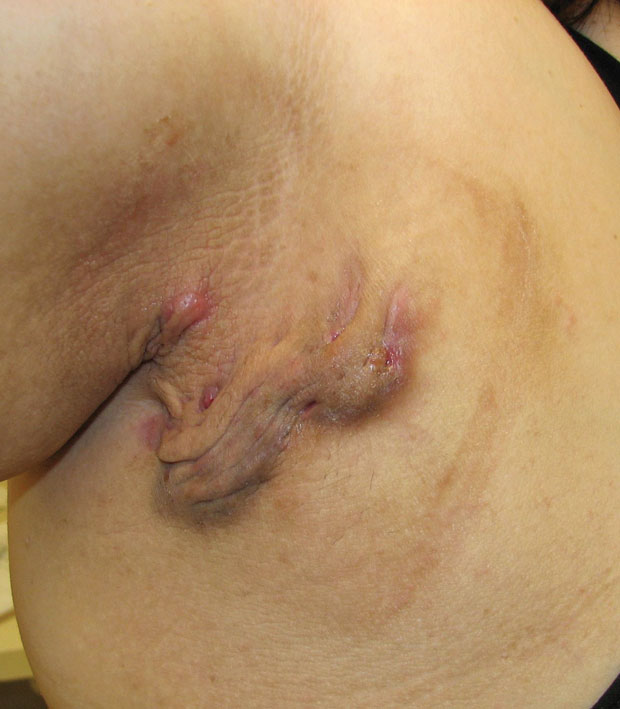MKSAP Quiz: Evaluation for hidradenitis suppurativa

A 32-year-old woman is evaluated for hidradenitis suppurativa. She has had tender, foul-smelling, draining nodules in the axillary folds for 4 years. Doxycycline and topical clindamycin have not achieved satisfactory improvement. She has a 10–pack-year smoking history.
On physical examination, vital signs are normal. BMI is 30. The left axilla is shown.
Behavioral counseling for smoking cessation and pharmacologic treatment are offered. The patient agrees to see a nutritionist for weight loss counseling.
Which of the following is the most appropriate additional treatment?
A. Acitretin
B. Adalimumab
C. Methotrexate
D. Narrow-band ultraviolet B phototherapy
Answer and critique
The correct answer is B. Adalimumab. This item is Question 2 in MKSAP 19's General Internal Medicine 2 section.
Adalimumab (Option B), a tumor necrosis factor-α inhibitor, is the most appropriate additional treatment. It is the only FDA-approved therapy for hidradenitis suppurativa and is indicated for use in patients with moderate to severe disease. Moderate to severe disease is defined by the presence of multiple recurring nodules or the development of scarring. Hidradenitis suppurativa is an inflammatory skin disorder of the apocrine glands. This disease tends to occur more commonly in women and typically begins after puberty. The pathogenesis of hidradenitis begins with follicular occlusion, but not infection or inflammation of the apocrine glands. After occlusion, secretions build up in the follicular duct and result in rupture and a subsequent inflammatory reaction that resembles a bacterial abscess. An acute inflammatory reaction is then triggered in the surrounding tissue. The role of bacteria is controversial and is likely a secondary colonization, because lesions are initially sterile and antibiotics are not entirely effective in preventing new lesions. The chronic and recurrent nature of hidradenitis suppurativa helps distinguish it from other infectious causes. Areas frequently affected are intertriginous areas, such as the axilla, groin, and underneath the breasts. The condition is characterized by comedones, painful nodules, abscesses, draining sinuses, and scarring. Risk factors include obesity, metabolic syndrome, cigarette smoking, and family history. For this reason, weight loss and smoking cessation are an essential part of the treatment plan. Hidradenitis suppurativa is extremely difficult to treat. No single treatment has been effective for all patients; however, several options are available. Decolonization with dilute bleach baths and chlorhexidine washes may be used in addition to topical clindamycin as initial therapy. For more extensive or resistant disease, common systemic treatments include oral antibiotics, such as tetracyclines or the combination of clindamycin and rifampin. This patient with several active lesions and scarring is experiencing moderate to severe disease, and treatment with adalimumab is indicated.
An oral retinoid, such as acitretin (Option A), is an excellent treatment option for hidradenitis suppurativa that fails to respond to initial therapy with topical or oral antibiotics and other adjunctive therapies. Nonadherence is common due to side effects. However, coadministration with doxycycline poses an unacceptable high risk for the patient to develop idiopathic intracranial hypertension and is therefore not the best choice for additional therapy.
Methotrexate (Option C) has not been shown to be efficacious in hidradenitis suppurativa and should not be prescribed.
Narrow-band ultraviolet B phototherapy (Option D) is a powerful tool in the treatment of psoriasis vulgaris and other conditions, such as mycosis fungoides, atopic dermatitis, and vitiligo, but has no role in treatment of hidradenitis suppurativa.
Key Points
- Hidradenitis suppurativa is associated with smoking, obesity, and metabolic syndrome, and these conditions should be addressed.
- Adalimumab is FDA approved for moderate to severe hidradenitis, defined by the presence of diffuse nodules or scar formation.




